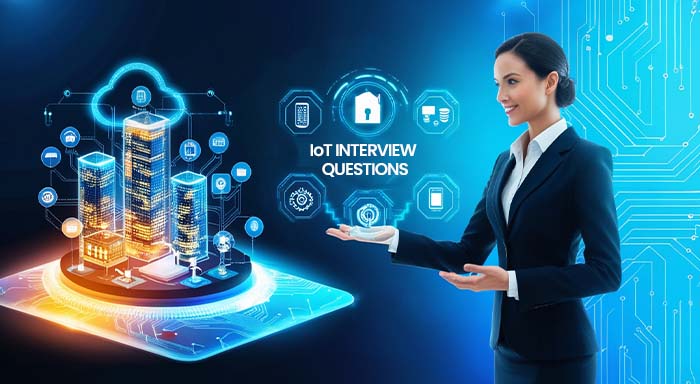Developing a career in the IoT industry is an interesting choice as it already employs 2 million IoT developers working on diverse projects. It is a flourishing field with great demand and prospects in worldwide industries. It is a preferable career choice, especially for candidates with a passion for technology and innovation. However, to be successful in this domain, candidates must have strong technical skill sets, problem-solving skills, and creative thinking. It is necessary to be aware of top IoT interview questions to prepare well for the interview.
The blog explores basic interview questions for candidates related to the planning, deployment, and maintenance of the Internet of Things. You will find questions for both beginners and seasoned professionals. Readers can also consider the blog as preparation material for IoT viva questions. So, let’s begin with questions and answers.
Best Internet of Things Interview Questions for Freshers and Experienced Professionals
To clear an IoT interview, the candidates must be well-informed about the fundamentals. Moreover, they should know all the programming languages, network technologies, and hardware related to an IoT environment. These IoT engineer questions assess whether the candidate has the requisites to meet the demand of the dynamic IoT industry.
IoT Interview Questions for Freshers
Q1. What Is the Internet of Things?
A- The Internet of Things is a technology that involves interconnectivity between various smart devices for effective collection, sharing, and exchange of data. An IoT environment involves embedded systems or IoT devices that perform a variety of tasks. IoT devices can be anything from wearables, implants, and applications to high-scale industrial machinery.
Q2. Explain briefly how IoT works.
A- In a nutshell, connected devices have IoT sensors that collect data from an environment. This collected data is then shared via a secure network to the cloud, where it is processed and analyzed. After analyzing, the software then sends the data to end-users in a user-friendly format.
Q3. What is the history of IoT?
A- Though IoT is a modern and advanced technology, its roots go way back to the 1980s. It was at Carnegie Mellon University that some students decided to enhance the Cola vending machine to monitor its content from a distance. The term was coined by Kevin Ashton while he was working at Procter & Gamble. From 2000 onwards, the general interest in IoT technology began to take off as more and more IoT-connected devices emerged.
Q4. What are the major industries that benefit from the Internet of Things?
A- The predominant industries that benefit from the Internet of Things technology include:
- Agriculture
- Healthcare
- Manufacturing
- Automotive
- Utilities
- Energy
- Smart homes
- Consumer devices
- Public Transportation
Q5. What are the advantages of IoT?
A- The business advantages of IoT include control and automation, real-time data accessibility, improved productivity, enhanced safety, data-based decision-making, predictive analytics, etc.
Q6. What are the major applications of IoT?
A- Applications of IoT encompass numerous industries. For example, IoT in healthcare can help in aspects like patient monitoring, diagnostics, telemedicine, centralizing patient data, and personalized treatment plans. In agriculture, it can be used in precision farming, smart agriculture, weather stations, monitoring crops, tracking soil conditions, etc. In energy management, it can be used in smart grids, energy management systems, and smart meters.
Q7. What is an embedded system?
A- An embedded system is an integration between software, hardware, and firmware to achieve a certain objective. It can have fixed functionality or can be programmable as per the requirements. In the domain of IoT, embedded systems are essential for collecting, processing, and transmitting information between numerous systems and devices. They can be incorporated into other IoT systems like vehicles, appliances, and medical equipment.
Q8. What are the components of IoT?
A- The main components that form an IoT environment include IoT actuators, sensors and, gateways, data processing and analytics, cloud platforms, user interfaces, network connectivity, security, etc.
Q9. What is the conceptual framework of IoT?
A- The conceptual framework of IoT involves a well-defined ecosystem that explains the interconnection between various technologies. Basically, it tells us how information travels from sensor collection to the analysis stage. It establishes the bridge between the digital and physical world. The four layers included in the conceptual framework of IoT include the access layer, connectivity layer, service layer, abstraction layer, etc.
Q10. What are the logical and physical designs of IoT?
A- In the physical design of IoT, we focus on the individual systems and devices linked with the IoT network. It also deals with numerous protocols that are utilized to establish an operational IoT environment. It refers to the main design of the IoT system and describes the configuration and assembly of various IoT components like sensors, actuators, and computers. The logical design is then further divided into IoT functional blocks, communication APIs, and communication models.
Q11. Describe the functional blocks of IoT.
A- The functional blocks of IoT include all the functioning modules, systems, and components of IoT. These functional blocks enable IoT to create a smart environment, i.e., collect information, process it, or communicate with other IoT systems. Only with the help of these functional blocks can the IoT environment work as intended.
IoT Interview Questions for Experienced Professionals
Q12. What is the significance of the scalability of IoT infrastructure?
A- An IoT environment can incorporate a large number of devices and data. As devices grow, traffic entering the IoT ecosystem can also grow. So, to accommodate this increase in traffic without slowing down, the IoT infrastructure needs to be scalable. Scalability is not only important for high performance but also vital for future growth.
Q13. Name a few common coding languages that are utilized in IoT development.
A- The primary programming languages utilized in the development of the IoT environment include Python, C/C++, Java, JavaScript, and Swift. Due to its advantages in memory safety, Rust has gained popularity in recent years.
Q14. What are the most important communication protocols utilized in IoT?
A- The most significant protocols for short-range communication in the IoT environment include CoAP, MQTT, Zigbee, Bluetooth, and Z-wave. For long-range and low-power communication, we have protocols like LoRa/LoRaWAN.
Q15. What is the difference between MQTT and COAP?
A- They differ in terms of communication model, RESTful Based, persistence support, communication type, message labeling, etc. Essentially, MQTT works on TCP protocol while COAP works on UDP protocol. The communication model in MQTT is many-to-many, while in COAP, it is one-to-one. Moreover, MQTT does not utilize REST methods, while COAP uses REST principles.
Q16. What are the challenges of IoT that manufacturers need to resolve?
A- The main challenges faced by IoT manufacturers include interoperability, cyberattacks, data privacy, authentication challenges, cost considerations, real-time performance, power consumption, regulatory compliance, etc.
Q17. What is edge computing in IoT?
A- Edge computing is a type of distributed computing model that involves the storage and processing of data closer to the storage. It helps users move away from a centralized cloud, which decreases latency and bandwidth usage. It is useful in all applications involving real-time data processing and situations where there is limited connectivity.
Q18. Can you give an example of how IoT can enhance business efficiency?
A- In the industry of logistics, for example, the Internet of Things can substantially enhance efficiency by enhancing real-time monitoring of shipments. This not only streamlines delivery routes but also minimizes delays. Moreover, there are IoT sensors that can track the status of stocks in transportation. This not only maintains overall quality but also minimizes losses.
Q19. How would you execute a simple IoT device that transfers data to a cloud service?
A- We can easily implement a standard IoT system for data transmission to cloud service. In order to do that, we need hardware devices like microcontrollers and sensors. Set up a device that can be linked to Wi-Fi or any other secure internet network. Leverage the API of the cloud platform to securely send and store data.
Q20. Create a Python program to publish sensor information to an MQTT broker. The program should have a function that can take humidity and temperature data and publish it to a topic which we will call “sensor/readings”.
- The Python program is as follows-
import paho.mqtt.client as mqtt
import json
def publish_sensor_data(temperature, humidity):
# Create an MQTT client and connect to broker
client = mqtt.Client()
client.connect("mqtt.broker.address", 1883, 60)
# Prepare sensor data payload
payload = json.dumps({
"temperature": temperature,
"humidity": humidity,
"timestamp": "2025-04-02T12:00:00Z"
})
# Publish to sensors/readings topic
client.publish("sensors/readings", payload, qos=1)
client.disconnect()Q21. Can you write an Arduino function ESP32 device that reads a sensor value, transmits it over a network (WiFi), and then goes to deep sleep mode for 15 minutes in order to save battery?
Here is the program-
#include <WiFi.h>
#include <HTTPClient.h>
#include "esp_sleep.h"
#define SENSOR_PIN 36
#define SLEEP_TIME 900000000 // 15 minutes in microseconds
void sendDataAndSleep() {
// Read sensor value
int sensorValue = analogRead(SENSOR_PIN);
// Connect to WiFi
WiFi.begin("NetworkSSID", "Password");
while (WiFi.status() != WL_CONNECTED) {
delay(500);
}
// Send data to server
HTTPClient http;
http.begin("https://your-server.com/data");
http.addHeader("Content-Type", "application/json");
String payload = "{\"value\":" + String(sensorValue) + "}";
http.POST(payload);
http.end();
// Disconnect WiFi and enter deep sleep
WiFi.disconnect(true);
esp_deep_sleep(SLEEP_TIME);
}
Note: For the above two questions, you can create a completely separate program from your knowledge and experience that can answer the question in fewer lines of code. In order for the codes to work, the environment must have the required libraries.
Q22. What is SSH protocol in IoT?
A- SSH, also known as Secure Shell, is a network communication protocol that establishes encrypted connections for file transfers and remote logins between two computers. SSH is mainly used for remote controlling servers, for handling infrastructure, and for transferring files.
Conclusion
Many candidates look for job opportunities in IoT industries because of real-world applications of their work, future potential, and high-salary prospects. However, it is a demanding field, and thus, it is important to be in tune with all the technical skillsets and subject knowledge. The blog focuses on IoT interview questions and covers questions for both freshers and experienced professionals.
There are other questions that you should be familiar with, for example, IoT security interview questions, which focus on security aspects of IoT. Candidates must have end-to-end knowledge of IoT to ace the interview and get good job opportunities. For more blogs on IoT, check out our website.



